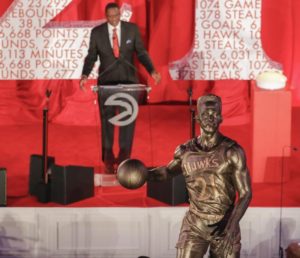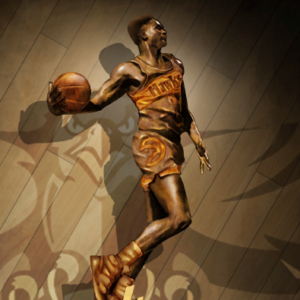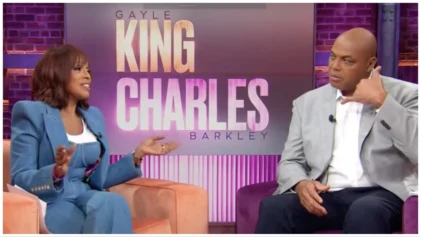Atlanta was not always a place of opportunity and social extravagance—real or imagined—for Black people. It evolved into it, gradually, with the mid-1980s an integral part of that emergence. That’s what the Hawks’ first-class unveiling of a statue of Dominique Wilkins today represents—a time when Atlanta blossomed into the capital of the new South.
Wilkins—with his exhilarating play on the court and his goodwill nature off of it—was a part of the city’s burgeoning reputation as a place African-Americans could come and prosper, and have a good time doing it.
As he crafted a Hall of Fame career, Wilkins earned an unofficial title as ambassador of the city. He was unique more than for his mesmerizing slam dunks and dexterous scoring ability at the old Omni. He was a superstar about town. He was touchable, likable, a man of the city. His city.
From his nightclub, Dominique’s, in downtown Atlanta to one he co-owned with Deion Sanders in Marietta called 21, Wilkins lived the city. He didn’t just play there.
“And that’s what made him special,” Atlanta mayor Kasim Reed said in renaming a part of Centennial Boulevard by Philips Arena “Dominique Wilkins Lane,” as part of a ceremony the Hawks’ organization can be proud of.
It honored Wilkins in a deserving, majestic way at Philips Arena, with a luncheon, video presentations, dignitaries and attendees like Julius Erving, Bernard King, Charles Oakley, Chris Tucker, Judge Glenda Hatchette, Charles Barkley, Clyde Drexler, Karl (Mailman) Malone, former mayor Bill Campbell and many others.
Even NBA commissioner Adam Silver, who lives in New York, expressed how invaluable Wilkins has been to Atlanta in general, the Black community in particular.
“Dominique is a part of the fabric of the community,” Silver said.
Some who did not experience what Atlanta was like in the ‘80s, during Wilkins’ reign, may not understand how a basketball player could galvanize a community. He did.
“In the beginning, I wasn’t trying to do that,” Wilkins said to Atlanta Blackstar. “But I went out in the city everyday, to Lenox Square and Phipps Plaza and the clubs and restaurants, and everywhere I went I met people who said they felt like I represented them. They enjoyed seeing me and I always embraced them.
“I realized pretty quickly that what we were doing as a team and what I was doing as an individual, socializing with the people, meant a lot. And it became important to me that I truly become a part of the city, the growth of the city.”
He did. Wilkins was omnipresent in Atlanta, long before it became the place for celebrities it is now. He was a one-man visitor’s bureau highlight—if you visited Atlanta and went out, you were bound to see Dominique.
“And that meant something to a lot of people and to the image of the city,” Wilkins’ younger brother, former NBA player Gerald Wilkins told Atlanta Blackstar at the ceremony. “That’s what this is about, this ceremony. More than basketball.
“Guess what? My brother wasn’t named one of the 50 greatest players when they named that team years ago. We know it was crazy, but he was left off. He never won a championship. He wasn’t really given the credit he was as a true superstar, despite his numbers. But he still got a statue. And you know why? For the person he is. For what he has been to the city. For what he represents to Atlanta.”
In his first moments after the unveiling of the beautiful statue, which depicts Wilkins in the process of throwing down one of his signature dunks, Wilkins went nostalgic.
“This moment takes me back to a lady who raised eight kids in the projects of Baltimore and taught us honor and respect and dignity,” he said of his mother, Gertrude.
Those characteristics were embedded in Wilkins. He lost money during his playing days because he took care of his extensive family and he believed people were as trustworthy as he. But he plowed on, always with a welcoming smile and with his head up.
Many who spoke today spoke of the man more than the player who scored more that 26,000 points in his career and was enshrined in the Basketball Hall of Fame in 2006.
“In seven years with Dominique,” former coach Mike Fratello said, “I never saw him turn down an autograph.”
Those kinds of recollections went on for a long time. They defined the man more than his freakish athleticism.
“This moment means more than you know,” Wilkins said. “This statue stands for change, change of the city.”
The change in Atlanta from then to now is vast, and Wilkins had a hand in it more than most. He helped Atlanta become Atlanta. And now, rightfully, there’s a monument outside the arena he used as a platform to remind us all of that.




